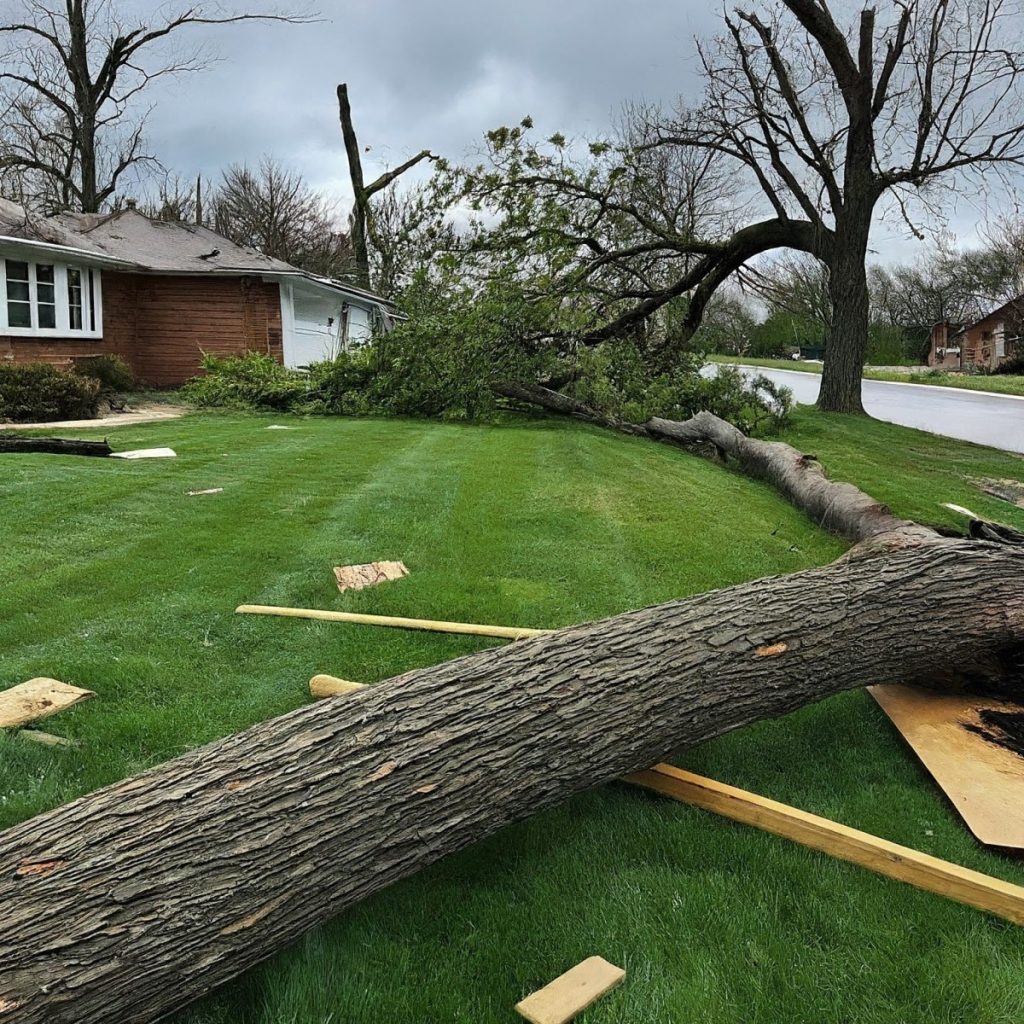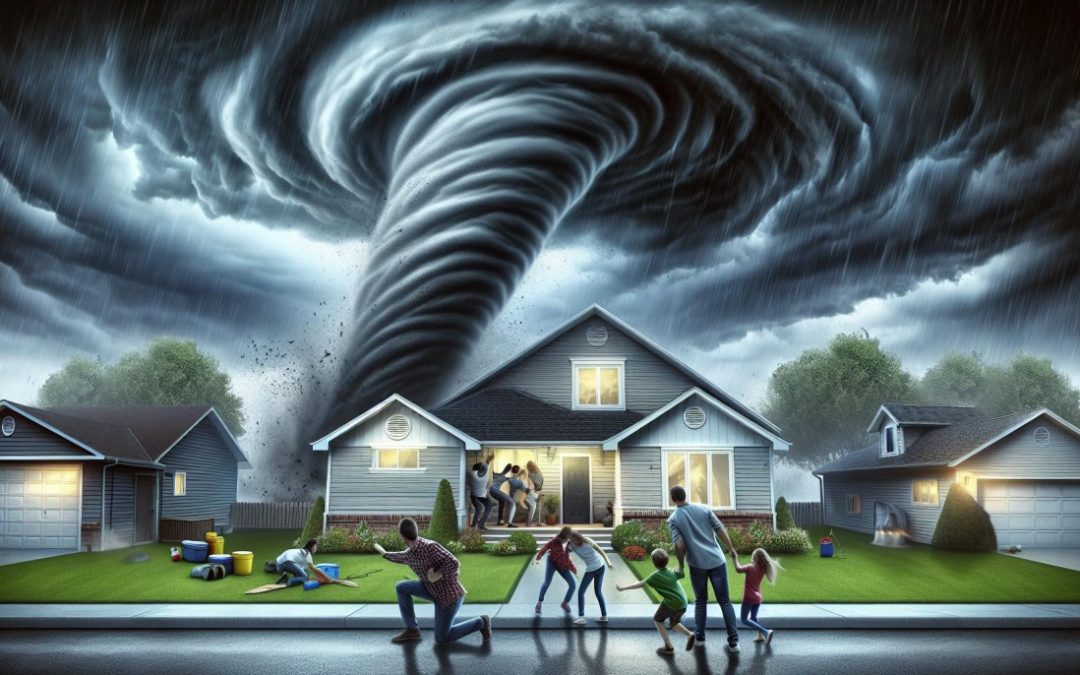Have you ever found yourself staring out the window at darkening skies, wondering if you’re truly prepared for what’s coming? This last week we saw some pretty strong storms come through the Metro East area.
Whether it’s a howling hurricane or a sudden snowstorm, the wrath of Mother Nature can catch even the most seasoned among us off guard. I’ve seen my share of close calls and last-minute scrambles, and I’ve learned that the key to weathering any storm lies in preparation.
The truth is, while we can’t control the weather, we can certainly arm ourselves with knowledge and tools to face it head-on. This article aims to be your go-to guide for storm readiness, offering practical advice and actionable steps to ensure you and your loved ones remain safe and secure.
From understanding the essentials of an emergency kit to learning how to secure your home against fierce winds, I’ll walk you through everything you need to know to stand firm when the skies turn grim.
Briefly describe the recent storms in Metro East Illinois
Metro East Illinois recently experienced a series of intense weather events, showcasing the raw power of nature. These storms unleashed heavy rainfalls, strong winds, and even instances of hail, causing significant damage to properties and infrastructure. My focus on storm preparedness’s importance stems from observing these events’ impacts.
Emphasize the Importance of Being Prepared for Future Storms
Understanding the intensity and aftermath of the storms that hit Metro East Illinois, I emphasize the crucial need for readiness. These natural events serve as a stark reminder that the unexpected can happen at any moment.

By preparing for future storms, individuals ensure the safety of their homes, families, and communities. From assembling an emergency kit to fortifying your home against severe weather, each step taken toward preparedness significantly reduces the risk of damage and injury.
For me, witnessing the resilience of those affected by the storms in Metro East Illinois underlines the importance of proactive measures. Armed with knowledge and the proper tools, we can all stand a better chance against the formidable force of nature.
II. Understanding Storm Risks
Recognizing the types of storms that strike Metro East Illinois and their potential dangers is critical. This knowledge not only helps in effective planning but also in adopting specific preparedness measures.
Types of Storms Common in Metro East Illinois
Metro East Illinois faces several types of storms, each carrying unique risks.
Tornadoes
Tornadoes are violent windstorms characterized by a twisting, funnel-shaped cloud. They can devastate a neighborhood in seconds with wind speeds exceeding 250 miles per hour.

Severe Thunderstorms
These storms bring heavy rain, lightning, thunder, and strong winds. Hail can also accompany severe thunderstorms, causing damage to property and crops.
Flooding
Resulting from heavy rain or storm surges, flooding can wash away roads, bridges, and buildings. It poses a significant risk, especially in low-lying areas.
Potential Dangers and Consequences of Each Type of Storm
Tornadoes
The most immediate danger from tornadoes includes the destruction of buildings, uprooting of trees, and vehicles being tossed through the air. Injuries or fatalities can occur if individuals find themselves in the path of a tornado without adequate shelter.
Severe Thunderstorms
The consequences of severe thunderstorms encompass a broad spectrum. From structural damage caused by high winds to fires from lightning strikes, the damage can be extensive. Power outages may last for days, complicating rescue and recovery efforts.
Flooding
Flooding introduces numerous hazards. Water contamination poses serious health risks, destroyed infrastructures hinder emergency and recovery efforts, and the economic impact can be staggering. The aftermath of flooding can linger, making the recovery process challenging and lengthy.
Understanding these risks is paramount. With this foundation, individuals can make informed decisions regarding their storm readiness strategies, ensuring they are better equipped to handle whatever nature throws their way.
III. Preparation Essentials
Having discussed the types of storms and their immediate threats to the Metro East Illinois region, I now turn my attention to the critical steps essential for effective storm readiness. These preparation essentials are indispensable tools and strategies that ensure safety and provide peace of mind during severe weather conditions.
Create an Emergency Kit
Water and Non-perishable Food
Every emergency kit must include a sufficient supply of water and non-perishable food items. I recommend storing at least one gallon of water per person per day for a minimum of three days. Non-perishable food items, such as canned goods, energy bars, and dried fruits, are crucial for maintaining nutrition when access to fresh food might be limited.

First Aid Supplies
A comprehensive first aid kit is another cornerstone of preparedness. It should include bandages, antiseptics, a thermometer, prescription medications, and pain relievers. Having these supplies at hand can address minor injuries and health issues immediately, potentially averting more serious complications.
Flashlights and Batteries
Power outages are a common consequence of storms, making flashlights and an ample supply of batteries essential. I ensure my kit contains LED flashlights for their long battery life and durability, alongside additional batteries to sustain them through prolonged use.
Radio and Charger
A battery-powered or hand-crank radio keeps you informed about weather updates and emergency instructions when conventional communication methods might be unavailable. I also include a solar charger in my kit, ensuring my cell phone remains operational for critical calls.
Important Documents
Protecting important documents is often overlooked in storm preparation. I securely store copies of personal identification, insurance policies, and financial records in a waterproof container to safeguard against potential water damage.
Develop a Family Emergency Plan
Creating and practicing a family emergency plan is paramount. This plan includes designated safe spots in the house for shelter during a storm, a list of emergency contacts, and pre-determined meetup points outside the home in case of evacuation. Ensuring every family member knows the plan, including children, can significantly sharpen your readiness for unexpected events.

By meticulously assembling an emergency kit and developing a comprehensive family emergency plan, I arm myself and my loved ones with the tools and knowledge necessary for navigating the unforeseen challenges posed by severe weather with confidence and calm.
IV. Home Preparation
Following the discussion on the essentials of storm preparation, focusing on the importance of emergency kits and the development of a family emergency plan, I turn my attention to securing the home against potential storm damage. This section details practical steps homeowners can implement to minimize risks during severe weather events.
Secure Outdoor Items
Securing outdoor items is critical in preventing them from becoming projectiles during high winds. I recommend storing patio furniture, garden tools, and toys in a shed or garage. For items that cannot be moved, such as gas grills or permanent fixtures, anchoring them firmly to the ground ensures they stay put during a storm.
Trim Trees and Shrubs
Weak branches can easily break off and cause damage to the home during severe weather. Regularly trimming trees and shrubs reduces the risk of such incidents. It’s advisable to remove limbs that hang too close to the house or electrical wires to eliminate potential threats.
Consider Installing Storm Shutters
Storm shutters offer an effective layer of protection for windows against high winds and flying debris. Permanent shutters can be closed quickly when a storm is imminent, while removable options can be installed ahead of a predicted severe weather event. They not only protect windows but can also help prevent interior water damage.
Reinforce Doors and Garage Doors
Doors, especially garage doors, are vulnerable to high winds. Reinforcing them can prevent the wind from blowing them in or sucking them out, which can lead to significant structural damage. Installing heavy-duty door braces and ensuring garage doors meet wind-load requirements for the area are beneficial measures.

Sign Up for Emergency Alerts
Staying informed is key during any emergency. Signing up for local emergency alerts ensures I receive timely notifications about severe weather conditions directly on my phone. This allows for adequate preparation time or, if necessary, evacuation.
Monitor Local News and Weather
Besides emergency alerts, I constantly monitor local news and weather forecasts during storm seasons. Weather apps and channels provide up-to-date information on storm paths, intensity, and expected impacts, enabling me to make informed decisions about protecting my home and family.
By integrating these home preparation strategies into my overall storm readiness plan, I significantly improve my resilience to severe weather, ensuring the safety and security of my household.
V. Staying Informed
In the context of storm readiness, one cannot underestimate the importance of staying informed. Timely and accurate information saves lives by enabling quick and informed decisions before, during, and after weather events.
Sign Up for Emergency Alerts From Local Authorities
Local governments and emergency services provide crucial alerts during severe weather situations. I recommend signing up for these notifications to receive real-time updates about impending storms. These alerts can inform you of evacuation orders, road closures, and safety instructions specific to your area.
For example, services like the Emergency Alert System (EAS) and National Oceanic and Atmospheric Administration (NOAA) Weather Radio offer nationwide alerts. Meanwhile, local services might use SMS or email systems to disseminate information.
Checking your local government or emergency management websites provides links and instructions on how to enroll in these notification services. Opting into these systems ensures that you receive the most pertinent and timely information.
Use a Weather App
Weather apps serve as essential tools for monitoring storm developments. They provide forecasts, radar images, and sometimes even customized alerts. I advocate for the selection of a reputable app, ones as the Weather Channel app or AccuWeather, which offer detailed forecasts and severe weather alerts.
Customize your app settings to alert you about severe weather advisories in your area. This customization enables you to prepare for sudden weather changes effectively.
Additionally, these apps often include features like interactive radar maps, giving you a visual understanding of the weather patterns affecting your region. Integrating technology into your readiness plan by utilizing a weather app complements traditional information sources, ensuring you are aware of any potential threats.
VI. Safety During the Storm
In this critical phase of a storm, ensuring personal and family safety becomes the primary concern. I’ll guide you through the essential actions to take during the storm to protect yourself and your loved ones.

Seek Shelter in a Designated Safe Room
Identify and use a safe room within your home, typically a small, windowless interior room or basement, for maximum protection during severe storms. This space should be pre-determined as part of your emergency plan.
Basements provide the best refuge in case of tornadoes, offering substantial protection against high winds and flying debris. If a basement is unavailable, choose an interior bathroom, closet, or hallway on the lowest level of your home. Gather everyone into this safe room, bringing your emergency kit along.
Avoid Windows and Exterior Walls
Minimize your risk during a storm by staying away from windows, glass doors, and exterior walls. Glass can shatter and cause injuries, while exterior walls are more susceptible to damage from high winds or flying debris.
Sit or crouch against an interior wall, preferably under a sturdy piece of furniture, like a table, to protect from potential ceiling collapses or debris. Covering yourself with thick padding, such as mattresses, can also provide additional protection.
Stay Away from Flooded Areas
Avoid any contact with floodwaters, both inside and outside your home. Flooded areas can swiftly become dangerous, hiding live electrical wires, contaminants, and sharp objects. If you encounter flooding in your home, prioritize turning off the main power if it is safe to do so to prevent electrical hazards.
Do not attempt to walk, swim, or drive through floodwaters. Remember, it only takes six inches of moving water to knock a person off their feet, and one foot of water to move most vehicles.
Maintaining safety during a storm involves being proactive and making informed decisions based on the situation’s severity. My recommendations emphasize finding shelter, avoiding potential hazards within the home, and steering clear of floodwaters to ensure that you and your family remain safe until the storm passes.
VII. After the Storm
In the wake of a storm, certain steps are crucial to ensure safety and begin the recovery process efficiently. The following guidelines will help navigate the aftermath with caution and effectiveness.
Be Cautious When Exiting Your Home or Shelter
When the storm has passed, it’s paramount to ensure the safety of any area before exiting. Inspect the surroundings for potential hazards such as downed power lines, structural damages, and flooded areas.

If you suspect gas leaks or detect a gas odor, do not use electrical devices, including cell phones, and evacuate immediately to notify emergency services. Wait for official confirmation that it’s safe to leave the shelter or re-enter homes, especially when dealing with the aftermath of tornadoes, severe thunderstorms, or flooding.
Assess Damage and Take Photos for Insurance Purposes
Upon ensuring that it’s safe to do so, conducting a thorough assessment of the property for any damage becomes my next priority. Document all damages by taking photos or videos before starting any clean-up efforts.
This documentation is crucial for filing insurance claims accurately and efficiently. Make sure to capture the extent of the damage both inside and outside the home, including vehicles and other personal property. Keep records and receipts of any repairs and clean-up costs, as these are essential for insurance purposes.
Follow Instructions from Local Authorities for Recovery
Local authorities provide vital information and instructions for the community’s recovery phase. They offer updates on safety, road closures, power restoration, and where to find assistance for affected residents.
I ensure to stay informed by tuning into local radio stations, following trusted social media accounts and checking official websites. Adhering to their advice and instructions helps in navigating the recovery process systematically and safely.
Furthermore, local authorities often coordinate with relief organizations to set up shelters, distribute supplies, and provide medical care for those in need, highlighting the importance of following their guidance post-storm.
VIII. Conclusion
Preparing for the unexpected is not just about securing our homes or stocking up on supplies. It’s about safeguarding our families and ensuring we can weather any storm with resilience. The steps we’ve discussed are a testament to the power of preparation.
By embracing these practices, we’re not just responding to the threats posed by severe weather; we’re actively taking control of our safety and recovery process. Let’s not wait for the next storm to remind us of what we should have done.
Instead, let’s commit to readiness today, ensuring that when the skies darken, we stand ready, not fearful. Together, we can face the unexpected with confidence and emerge stronger on the other side.
We hope you are enjoying these articles and are willing to continue to follow along as we share our adventures of learning about life in southern Illinois, This is an exciting area and we are so happy to be part of this area. Our lives are being fulfilled by the people we are meeting. Bruce & Karen.
This website is a participant in the Amazon Services LLC Associates Program, an affiliate advertising program designed to provide a means for sites to earn advertising fees by advertising and linking to Amazon.com and affiliated sites. As an Amazon Associate, I earn from qualifying purchases.
We’re Bruce and Karen Carlson. We recently moved to the Metro East area of Illinois. This area is east of St. Louis from the Mississippi River north to Alton, east to Carlyle, back south to Waterloo and the Mississippi River, finally north to Columbia. The center is Fairview Heights, Swansea, Belleville, Shiloh, and O'Fallon. Not to be forgotten is Southern Illinois University (SIU) in Edwardsville. It’s a whole new world out there. Our goal with this website is to share our exploration of the Metro East area. As we find businesses and services we use in our daily lives, we’ll share how these businesses and services have helped make our lives better and easier to live.
We’re calling our move to the Metro East area retirement, but we’re not quite sure what that means. By sharing our story with you, we hope you too will gain a better sense of what the Metro East area has to offer and how their businesses and services can improve your lives and build a better community.


